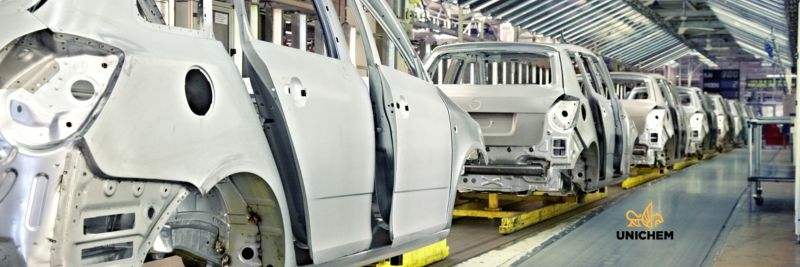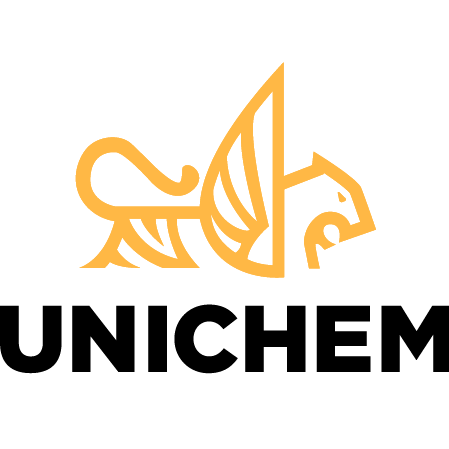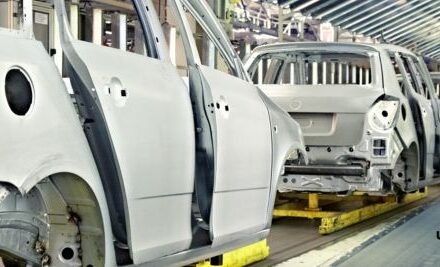
Manufacturers selecting coil-applied adhesives must balance production speed, end-use durability, and thermal processing requirements. Thermoset adhesives support these goals with rapid in-line curing, consistent bond strength, and compatibility with continuous lamination systems. Choosing between single-stage and B-stage curing systems helps align adhesive performance with the specific demands of coil-laminated products.
How Curing Strategy Impacts Efficiency, Bond Strength, and Line Integration
Understanding how these curing approaches differ, from their processing windows to their final bond characteristics, allows engineers to design lamination systems that deliver both throughput and reliability. This article breaks down the functional differences between thermosetting adhesives and B-stage curing systems, including where each fits in modern coil coating lines.
Thermoset Adhesives and the Single-Stage Cure
Thermosetting adhesives are formulated to cure irreversibly when exposed to heat, forming a permanent bond through chemical crosslinking. This process occurs in a single stage, whereby the adhesive is applied via the coil coating process, and then becomes fully cured (thermal-set) during the coil-lamination process. Once cured, the chemical bonds within the adhesive are permanent, providing heat, water, and chemical resistance properties. The adhesives are designed to allow the metal substrates, bound by the adhesive, to be post-formed, as needed. The use of coil lamination, bringing together two metal substrates into a composite, provides excellent dimensional stability, thermal resistance, and mechanical strength under stress.
This single-stage curing mechanism is ideal for high-speed manufacturing environments where consistent bond performance and fast processing are essential. Thermoset systems are commonly used in applications where laminates will be exposed to elevated temperatures, mechanical loads, or chemical exposure, conditions where hot-melt or pressure-sensitive adhesives might fail. Because they cure completely during the lamination step, thermosetting adhesives streamline processing and reduce the need for secondary cure cycles.
B-Stage Curing Systems: Flexibility for Multi-Step Lamination
B-stage adhesives offer a different curing profile designed to accommodate multi-step lamination processes. These adhesives are partially cured, or “B-staged”, during the initial, coil coating, application step, transforming from a liquid to a tack-free solid film that can be handled, stored, or shipped without blocking or losing bond integrity. The final cure occurs later when heat and pressure are reapplied during a secondary forming or lamination step.
This two-step curing strategy provides manufacturers with greater flexibility in production workflows, particularly when a substrate is coated with adhesive at one location, but then transported and laminated to a secondary substrate at a second location. Once the lamination process is completed, the coil-laminated substrates can be processed further and prepared for forming, fabrication, and assembly. B-stage, systems are beneficial when the final product must undergo additional shaping, die-cutting, or molding before reaching its finished form.
UNICHEM formulates B-stage industrial adhesives that maintain excellent flow and wet-out during initial coil coating applications, while delivering strong final bonds after post-heating and becoming thermoset. These formulations support high-performance bonding in end-use environments that demand both dimensional precision and durability under thermal or chemical stress. Choosing between single-stage thermosetting and B-stage adhesives depends on production logistics, desired processing windows, and performance criteria for the finished product.
Matching Adhesive Strategy to Laminate Design and Line Requirements
Selecting the optimal adhesive system for coil-applied laminates begins with evaluating the specific end-use conditions and production parameters. Single-stage thermosetting adhesives are best suited for fast, in-line operations where laminates are immediately bonded and cured in one continuous process. These adhesives deliver maximum throughput and minimal handling, making them ideal for high-volume manufacturing environments with tight cycle times.
In contrast, B-stage adhesives offer advantages when the manufacturing process involves multiple forming steps, off-site assembly, or delayed final cure. By separating the application and curing phases, B-stage systems enable complex part geometries, reduce in-line processing time, and support flexible inventory management of pre-bonded substrates.
UNICHEM supports both approaches with advanced coil-applied adhesive formulations engineered to meet demanding performance metrics. Whether customers require heat-activated thermosetting adhesives for immediate curing or B-stage systems that integrate with post-forming operations, UNICHEM helps manufacturers align adhesive selection with operational needs, product specifications, and market demands.
Adhesive Curing Strategy Drives Coil Coating Performance
The choice between single-stage thermosetting adhesives and B-stage curing systems is not one-size-fits-all. Each approach supports different production workflows, bond durability requirements, and end-use applications. By offering both technologies, UNICHEM helps manufacturers achieve strong, reliable bonds while optimizing lamination line efficiency.
UNICHEM offers advanced coil-applied adhesive technologies for demanding industrial environments. We provide engineered thermosetting and B-stage solutions that align with your processing needs and product performance goals. Contact us today to learn how our thermoset adhesive systems can support your coil-laminated applications.


